
No. 1435 Flight Royal Air Force, commonly abbreviated 1435 Flt, is an independent aircraft flight of the Royal Air Force (RAF). Currently operating the Eurofighter Typhoon FGR4, it is based at RAF Mount Pleasant in the Falkland Islands. Its role is to provide air defence for the Falkland Islands, South Georgia and the South Sandwich Islands. Four aircraft are permanently based in the islands, whilst their pilots and groundcrew are cycled through No. 1435 Flight from the various Typhoon squadrons in the United Kingdom, providing a 24-hour, 365-day quick reaction alert (QRA) role.
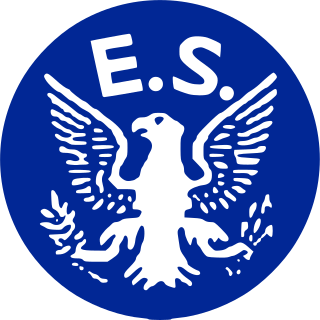
The Eagle Squadrons were three fighter squadrons of the Royal Air Force (RAF) formed with volunteer pilots from the United States during the early days of World War II (1940), prior to the United States' entry into the war in December 1941.

The 4th Fighter Group was an American element of the United States Army Air Forces (USAAF) Eighth Air Force during World War II. The group was known as the Debden Eagles because it was created from the three Eagle Squadrons of the Royal Air Force: No. 71, No. 121 Squadron RAF, and No. 133 Squadron RAF. These squadrons became the 334th, 335th, and 336th Fighter Squadrons of the 4th Fighter Group based at RAF Debden. The group was the first fighter group to fly combat missions over German airspace, the first to escort bombers over Berlin, and the first selected to escort bombers on shuttle bombing runs landing in Russia. The group was credited with shooting down 1,016 German planes.

Number 332 Squadron of the Royal Air Force was formed at RAF Catterick in the North Riding of Yorkshire on 16 January 1942, as a Supermarine Spitfire-equipped fighter squadron manned by Norwegians.

Tain Air Weapons Range is a Ministry of Defence air weapons range on the Dornoch Firth near Tain in Scotland. Royal Air Force aircrews from RAF Lossiemouth are trained in air weaponry on the range, along with NATO aircrew.

No. 331 Squadron RAF was a Second World War squadron of the Royal Air Force. The squadron was primarily manned with Norwegian aircrew. The squadron was part of Fighter Command between 1941 and March 1944 when it joined the 2nd Tactical Air Force until the end of the war. The squadron took part in the Dieppe Raid and the Normandy landings.
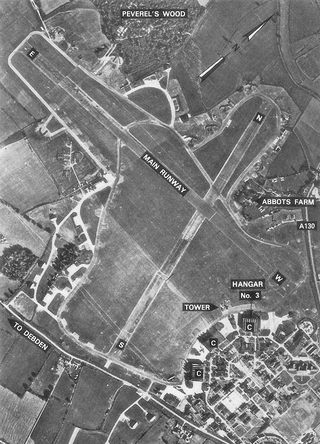
Royal Air Force Debden or more simply RAF Debden is a former Royal Air Force station located 3 miles (4.8 km) southeast of Saffron Walden and approximately 1 mile (1.6 km) north of the village of Debden in north Essex, England
Royal Air Force Montrose or more simply RAF Montrose is a former Royal Air Force station in Forfarshire in Scotland. It became the first operational military aerodrome to be established in the United Kingdom on 26 February 1913.

Royal Air Force Scorton or more simply RAF Scorton is a former Royal Air Force satellite station located next to the village of Scorton in North Yorkshire, England. The base was opened in October 1939 as part of 13 Group RAF Fighter Command and a satellite station of RAF Catterick. It was used by the Royal Air Force, the Royal Canadian Air Force, and the United States Army Air Forces Ninth Air Force during the war.
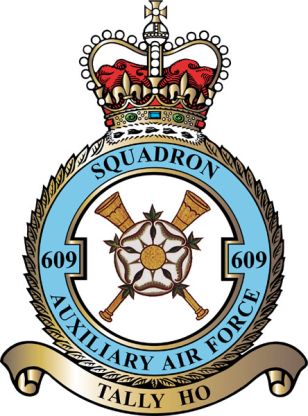
No. 609 Squadron of the Royal Auxiliary Air Force, originally formed as a bomber squadron and in the Second World War active as fighter squadron, nowadays provides personnel to augment and support the operations of the Royal Air Force. The squadron is no longer a flying squadron, but instead has the role of Force Protection. It is currently based at RAF Leeming, North Yorkshire.

Army Aviation Centre (AAC) Middle Wallop is a British Army airfield located near the Hampshire village of Middle Wallop, used for Army Air Corps training. The base hosts 2 (Training) Regiment AAC and 7 (Training) Regiment AAC under the umbrella of the Army Aviation Centre. 2 (Training) Regiment performs ground training; 7 (Training) Regiment trains aircrew on AAC aircraft after they complete basic training at RAF Shawbury.

The name No. 67 Squadron has been used by the Royal Flying Corps and the Royal Air Force for two quite different units.
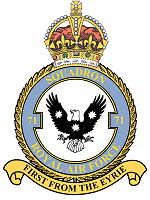
No. 71 Squadron was a Royal Air Force aircraft squadron. The number has been used three times: once by the Royal Flying Corps for an Australian Flying Corps squadron; in the Second World War as the first of three Eagle Squadrons; and post-war as a fighter-bomber unit under the command of Royal Air Force Germany.

Royal Air Force Chilbolton or RAF Chilbolton is a former Royal Air Force station in Hampshire, England. The airfield was located in Chilbolton approximately 4 miles (6.4 km) south-southeast of Andover, about 62 miles (100 km) southwest of London.

Royal Air Force Fairwood Common, or more simply RAF Fairwood Common, is a former Royal Air Force Sector Station located on Fairwood Common, on the Gower Peninsula, to the west of Swansea. It is now the location of Swansea Airport.

349th Squadron is a fighter squadron in the Air Component of the Belgian Armed Forces. The squadron traces its origins to No. 349 (Belgian) Squadron of the Royal Air Force, founded in 1942 as part of the Free Belgian forces during World War II. It was transferred to the re-established Belgian Air Force in 1946, together with 350th Squadron. Considered an "honorary" squadron, it retained its original name and numbering and has been flying under the Belgian flag ever since. Today it is part of the 10th Tactical Wing, operating the F-16 Fighting Falcon from Kleine Brogel airbase.
No. 225 Squadron RAF is a former Royal Air Force squadron.
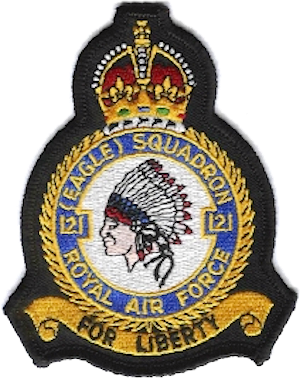
No. 121 Squadron was a Royal Air Force (RAF) aircraft squadron that during the Second World War was one of the three Eagle Squadrons manned by American volunteers. There is a Royal Air Force Air Cadets squadron, based in Nuneaton, which shares its number.

Royal Air Force Charmy Down or more simply RAF Charmy Down is a former Royal Air Force station in Somerset, England, approximately 3 miles (4.8 km) north-northeast of Bath and 96 miles (154 km) west of London.

















